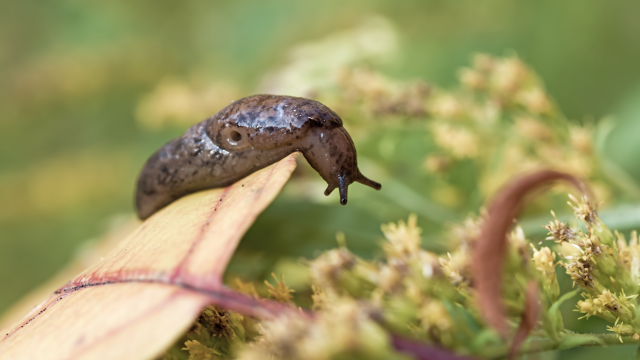08
Dec
Scientists Discover Parasite that “Liquifies” Slugs, Shows Promise as Potential New Biological Control

(Beyond Pesticides, December 8, 2020) Researchers at Oregon State University recently made a promising discovery that could significantly improve the ability for North American farmers and gardeners to manage invasive, crop damaging slugs. It isn’t a pesticide, but a nematode (Phasmarhabditis spp.), a microscopic animal whose phylum contains potentially millions of different species. Oregon State researchers think they’ve found the specific type of nematode that will parasitize and kill Deroceras reticulatum, also known as the grey garden slug. The research underscores the critical importance of funding and supporting research on biological controls and other non-toxic pest management approaches.
Researchers were keyed into the potential to use nematodes for slug biocontrol by a product that has been successfully used in Europe for over 25 years, known as Nemaslug. However, the product is not registered in the United States by the U.S. Environmental Protection Agency (EPA). “The thought process is that if it works in Europe and we find it here and it works here, it might be easier to get it registered by the EPA,” study coauthor Rory Mc Donnell, PhD, said. “If we can provide evidence it’s native, that makes a strong case for developing it as a bio-control. But we want to make sure there are no effects on native slugs or snails. We don’t want bio-control gone awry. That’s very, very important.”
To determine whether slug-predator nematodes are present in the U.S., scientists took nematode samples from Oregon fields and compared them to the Nemaslug strain, as well as other nematodes found throughout the world. Through a series of tests and DNA sequencing, it was determined that the strain found in Oregon is nearly identical to those in Nemaslug. The only difference is the absence of one bacterial species usually found around the specific nematode, and in the Nemaslug product. Subsequent testing found that several nematode species found in North America have the potential to kill garden slugs.
Although researchers point to the need for additional comprehensive testing to make certain there are no unintended side-effects from potential commercialization and widespread release of parasitic nematodes, it is clear that current management practices are insufficient. Although specific costs of slug damage in the US are unknown, it is likely to be in the 10s of millions.
Current practices rely on the use of molluscicides, such a metaldehyde or Iron Phosphate to manage slug populations. Beyond Pesticides strongly discourages use of metaldehye, as the chemical is a suggestive carcinogen, with evidence of neurotoxicity, kidney and liver damage, and reproductive harm. Iron Phosphate -found in products like Sluggo – is a common choice among organic growers as it is currently approved by the National Organic Program. But its efficacy relies on a synergy between iron phosphate and a so-called “inert” ingredient known as EDTA. Neither EDTA nor iron phosphate alone will manage slugs. Beyond Pesticides filed comments in 2014 urging delisting of iron phosphate in organic because of the risks EDTA poses to soil organisms, its ability to cause movement of harmful metals in sediment, and propensity of contaminate waterways.
Behind the potential dangers posed by slug pesticides lies the fact that they have relatively low efficacy. According to OSU researchers, control is between 10% to 60%. “The damage [slugs] cause is a massive issue,” Dr. Mc Donnell said. “We surveyed 200 growers throughout the Willamette Valley [Oregon] to gather their opinion of controlling slugs with pesticide. We found only 30% said they were happy with the performance of chemicals.”
The staying power of the slimy grey garden slug is one that necessitates the work being conducted by OSU researchers. By working with, rather than against natural processes, pest managers can leverage ecology to work towards human-focused goals. A study published in September determined that the development of biological controls over the last century had a greater benefit for agricultural economies than the green revolution. The piece urged scientists and policymakers to move past “a more risk-adverse attitude,” to biological management which, “eclipsed its myriad societal benefits.”
Such an approach would not be pretty for slug populations. “When a slug is infested with nematodes, it liquifies,” said study coauthor Dee Denver, PhD. “You end up with a swarming pile of worms. It’s pretty gruesome.”
Managing slugs is the bane of many American farmers and gardeners. Cultural practices can help get a handle on slug populations, but some form of direct control is often needed. Make sure to monitor slug populations regularly. Try to reduce moisture to prevent slugs from finding crops. Never water at night, and consider tactics like drip irrigation in particularly damp, slug-prone areas. Use of a trap crop that slugs prefer better may help attract slugs away from higher value crops. Traps using alcohol or yeast can work for some gardeners, but often provide inconsistent results and can sometimes attract more slugs. Picking slugs out of the garden with a disposable glove and placing them into soapy water to die can be objectively gross, but an effective way to reduce populations. If you or friends have domesticated foul like ducks, geese, or chickens, consider letting them run in a slug-infested garden (but keep an eye on them to prevent other damage).
See Beyond Pesticides ManageSafe webpage on least toxic control of snails and slugs for more information about how to safely address these problematic pests.
All unattributed positions and opinions in this piece are those of Beyond Pesticides.
Source: Oregon State University Press Release, PLOS One, Biological Control











Wow! Such a great article you have there especially now.I hope you will post more articles soon. Thank you.
February 23rd, 2021 at 11:07 pmThanks and Keep sharing. Keep safe.